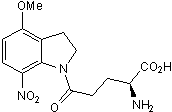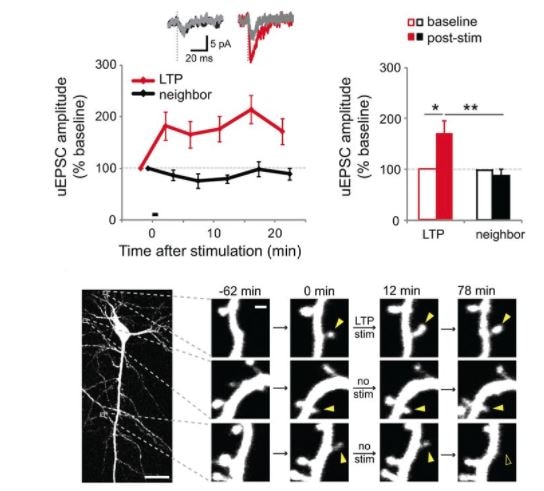MNI-caged-L-glutamate
Chemical Name: (S)-α-Amino-2,3-dihydro-4-methoxy-7-nitro-δ-oxo-1H-indole-1-pentanoic acid
Purity: ≥99%
Biological Activity
MNI-caged-L-glutamate is a form of glutamate linked to a photo-protecting group, 4-methoxy-7-nitroindolinyl (MNI); it rapidly and efficiently releases L-glutamate (Cat. No. 0218) by photolysis (300 - 380 nm excitation) with a quantum yield in the 0.065-0.085 range. It is also suitable for use with two-photon uncaging microscopy (cross-section of 0.06 GM at 730 nm). MNI-caged-L-glutamate is optically compatible with other chromophores used for fluorescence imaging, such as GFP, YFP and most Ca2+ dyes. MNI-caged-L-glutamate is 2.5-fold more efficient at releasing L-glutamate than NI-caged L-glutamate. MNI-caged-L-glutamate is water-soluble, stable at neutral pH, highly resistant to hydrolysis and pharmacologically inactive at neuronal glutamate receptors and transporters (up to mM concentrations). MNI-caged-L-glutamate can be used for in situ studies of fast synaptic glutamate receptors.View more information regarding MNI-caged-L-glutamate.
Technical Data
The technical data provided above is for guidance only.
For batch specific data refer to the Certificate of Analysis.
Tocris products are intended for laboratory research use only, unless stated otherwise.
Additional Information
Background References
-
New caged neurotransmitter analogs selective for glutamate receptor sub-types based on methoxynitroindoline and nitrophenylethoxycarbonyl caging groups.
Palma-Cerda et al.
Neuropharmacology., 2012;63:624 -
Photochemical and pharmacological evaluation of 7-nitroindolinyl- and 4-methoxy-7-nitroindolinyl-amino acids as novel, fast caged neurotransmitters.
Canepari et al.
J.Neurosci.Methods, 2001;112:29 -
Comparative analysis of inhibitory effects of caged ligands for the NMDA receptor.
Maier et al.
J.Neurosci.Methods, 2005;142:1 -
Dendritic spine geometry is critical for AMPA receptor expression in hippocampal CA1 pyramidal neurons.
Matsuzaki et al.
Nat.Neurosci., 2001;4:1086 -
Effects of aromatic substitutions on the photocleavage of 1-acyl-7-nitroindolines.
Papageorgiou and Corrie
Tetrahedron, 2000;56:8197
Product Datasheets
Reconstitution Calculator
Molarity Calculator
Citations for MNI-caged-L-glutamate
The citations listed below are publications that use Tocris products. Selected citations for MNI-caged-L-glutamate include:
61 Citations: Showing 1 - 10
-
Ketamine Rapidly Enhances Glutamate-Evoked Dendritic Spinogenesis in Medial Prefrontal Cortex Through Dopaminergic Mechanisms
Authors: Wu Et al.
Biol.Psychiatry 2021;89:1096
-
Stress undermines reward-guided cognitive performance through synaptic depression in the lateral habenula
Authors: Nuno-Perez
Neuron 2021;109:947
-
Neuronal morphologies built for reliable physiology in a rhythmic motor circuit.
Authors: Otopalik Et al.
Elife 2019;8
-
Precise Temporal Regulation of Molecular Diffusion within Dendritic Spines by Actin Polymers during Structural Plasticity.
Authors: Obashi Et al.
Cell Rep 2019;27:1503
-
Spike-timing-dependent plasticity rule for single, clustered and distributed dendritic spines.
Authors: Tazerart Et al.
Nat Commun 2019;11:4276
-
Probing Single Synapses via the Photolytic Release of Neurotransmitters
Authors: Mitchell Et al.
Front Synaptic Neurosci 2019;11
-
The CaMKII/NMDA receptor complex controls hippocampal synaptic transmission by kinase-dependent and independent mechanisms.
Authors: Incontro
Nat Commun 2018;9:2069
-
OXT functions as a spatiotemporal filter for excitatory synaptic inputs to VTA DA neurons.
Authors: Xiao Et al.
Elife 2018;7
-
Altered Excitability and Local Connectivity of mPFC-PAG Neurons in a Mouse Model of Neuropathic Pain.
Authors: Cheriyan and Sheets
J Neurosci 2018;38:4829
-
Sub-populations of Spinal V3 Interneurons Form Focal Modules of Layered Pre-motor Microcircuits.
Authors: Chopek Et al.
Cell Rep 2018;25:146
-
Neuronal Activity and Intracellular Calcium Levels Regulate Intracellular Transport of Newly Synthesized AMPAR.
Authors: Hangen Et al.
Cell Rep 2018;24:1001
-
Slow AMPAR Synaptic Transmission Is Determined by Stargazin and Glutamate Transporters.
Authors: Lu Et al.
Neuron 2017;96:73
-
CaMKII Autophosphorylation Is Necessary for Optimal Integration of Ca2+ Signals during LTP Induction, but Not Maintenance.
Authors: Chang Et al.
Neuron 2017;94:800
-
Formation and Maintenance of Functional Spines in the Absence of Presynaptic Glutamate Release.
Authors: Sigler Et al.
Neuron 2017;94:304
-
When complex neuronal structures may not matter.
Authors: Otopalik Et al.
Elife 2017;6
-
Serotonin enhances excitability and gamma frequency temporal integration in mouse prefrontal fast-spiking interneurons.
Authors: Athilingam Et al.
Elife 2017;6
-
Activity-dependent trafficking of lysosomes in dendrites and dendritic spines.
Authors: Goo Et al.
J Cell Biol 2017;216:2499
-
A Presynaptic Glutamate Receptor Subunit Confers Robustness to Neurotransmission and Homeostatic Potentiation.
Authors: Kiragasi Et al.
Cell Rep 2017;19:2694
-
Stereotyped initiation of retinal waves by bipolar cells via presynaptic NMDA autoreceptors.
Authors: Zhang Et al.
Nat.Commun. 2016;7:12650
-
A family of photoswitchable NMDA receptors.
Authors: Berlin Et al.
Elife 2016;5
-
17β-OEAcutely Potentiates Glutamatergic Synaptic Transmission in the Hippocampus through Distinct Mechanisms in Males and Females.
Authors: Oberlander
J Neurosci 2016;36:2677
-
The Shaping of Two Distinct Dendritic Spikes by A-Type Voltage-Gated K(+) Channels.
Authors: Yang Et al.
J Neurosci 2015;9:469
-
Highly differentiated cellular and circuit properties of infralimbic pyramidal neurons projecting to the periaqueductal gray and amygdala.
Authors: Ferreira Et al.
Nat Commun 2015;9:161
-
Optical control of NMDA receptors with a diffusible photoswitch.
Authors: Laprell Et al.
PLoS One 2015;6:8076
-
Distribution and function of HCN channels in the apical dendritic tuft of neocortical pyramidal neurons.
Authors: Harnett Et al.
PLoS One 2015;35:1024
-
Melanoma brain colonization involves the emergence of a brain-adaptive phenotype.
Authors: Nygaard Et al.
J Neurosci 2015;1:82
-
The Functional Organization of Neocortical Networks Investigated in Slices with Local Field Recordings and Laser Scanning Photostimulation.
Authors: Erlandson Et al.
Front Cell Neurosci 2015;10:e0132008
-
Fast Decay of CaMKII FRET Sensor Signal in Spines after LTP Induction Is Not Due to Its Dephosphorylation.
Authors: Otmakhov Et al.
Front Cell Neurosci 2015;10:e0130457
-
Spatially reciprocal inhibition of inhibition within a stimulus selection network in the avian midbrain.
Authors: Goddard Et al.
PLoS One 2014;9:e85865
-
Input integration around the dendritic branches in hippocampal dentate granule cells.
Authors: Kamijo Et al.
Cogn Neurodyn 2014;8:267
-
Adult neurogenesis modifies excitability of the dentate gyrus.
Authors: Ikrar Et al.
Front Neural Circuits 2014;7:204
-
Plasticity of binocularity and visual acuity are differentially limited by nogo receptor.
Authors: Stephany Et al.
J Neurosci 2014;34:11631
-
Directional summation in non-direction selective retinal ganglion cells.
Authors: Abbas Et al.
PLoS Comput Biol 2013;9:e1002969
-
Four-dimensional multi-site photolysis of caged neurotransmitters.
Authors: Go Et al.
Front Cell Neurosci 2013;7:231
-
Rapid, activity-independent turnover of vesicular transmitter content at a mixed glycine/GABA synapse.
Authors: Apostolides and Trussell
J Neurosci 2013;33:4768
-
Molecular layer perforant path-associated cells contribute to feed-forward inhibition in the adult dentate gyrus.
Authors: Li Et al.
Proc Natl Acad Sci U S A 2013;110:9106
-
Intrinsic connections in the anterior part of the bed nucleus of the stria terminalis.
Authors: Turesson Et al.
J Neurophysiol 2013;109:2438
-
Withdrawal from cocaine self-administration alters NMDA receptor-mediated Ca2+ entry in nucleus accumbens dendritic spines.
Authors: Ferrario Et al.
PLoS One 2012;7:e40898
-
Mechanism of inhibition of the glutamate transporter EAAC1 by the conformationally constrained glutamate analogue (+)-HIP-B.
Authors: Callender Et al.
Biochemistry 2012;51:5486
-
Alteration of synaptic network dynamics by the intellectual disability protein PAK3.
Authors: Dubos Et al.
J Neurosci 2012;32:519
-
Increased excitatory synaptic input to granule cells from hilar and CA3 regions in a rat model of temporal lobe epilepsy.
Authors: Zhang Et al.
J Neurosci 2012;32:1183
-
Neural circuit mechanisms for pattern detection and feature combination in olfactory cortex.
Authors: Davison and Ehlers
Neuron 2011;70:82
-
Oligodendrocytes as regulators of neuronal networks during early postnatal development.
Authors: Doretto Et al.
PLoS One 2011;6:e19849
-
Water and urea permeation pathways of the human excitatory amino acid transporter EAAT1.
Authors: Vandenberg Et al.
Biochem J 2011;439:333
-
NMDA receptor signaling in oligodendrocyte progenitors is not required for oligodendrogenesis and myelination.
Authors: Biase Et al.
Oncoscience 2011;31:12650
-
Hetero-oligomerization of neuronal glutamate transporters.
Authors: Nothmann Et al.
J Neurosci 2011;286:3935
-
Dysregulation of presynaptic calcium and synaptic plasticity in a mouse model of 22q11 deletion syndrome.
Authors: Earls Et al.
J Biol Chem 2010;30:15843
-
Mechanism of cation binding to the glutamate transporter EAAC1 probed with mutation of the conserved amino acid residue Thr101.
Authors: Tao Et al.
J Biol Chem 2010;285:17725
-
Discovery of a Novel Chemical Class of mGlu(5) Allosteric Ligands with Distinct Modes of Pharmacology.
Authors: Hammond Et al.
ACS Chem Neurosci 2010;1:702
-
High precision and fast functional mapping of cortical circuitry through a novel combination of voltage sensitive dye imaging and laser scanning photostimulation.
Authors: Xu Et al.
J Neurophysiol 2010;103:2301
-
SLM Microscopy: Scanless Two-Photon Imaging and Photostimulation with Spatial Light Modulators.
Authors: Nikolenko Et al.
Front Neural Circuits 2009;2:5
-
Robust short-latency perisomatic inhibition onto neocortical pyramidal cells detected by laser-scanning photostimulation.
Authors: Brill and Huguenard
J Neurosci 2009;29:7413
-
Synaptic circuit abnormalities of motor-frontal layer 2/3 pyramidal neurons in an RNA interference model of methyl-CpG-binding protein 2 deficiency.
Authors: Wood Et al.
Proc Natl Acad Sci U S A 2009;29:12440
-
Differential distribution of endoplasmic reticulum controls metabotropic signaling and plasticity at hippocampal synapses.
Authors: Holbro Et al.
Proc Natl Acad Sci U S A 2009;106:15055
-
Sequential changes in AMPA receptor targeting in the developing neocortical excitatory circuit.
Authors: Brill and Huguenard
J Reprod Dev 2008;28:13918
-
Natural oligomers of the Alzheimer amyloid-beta protein induce reversible synapse loss by modulating an NMDA-type glutamate receptor-dependent signaling pathway.
Authors: Shankar Et al.
J Neurosci 2007;27:2866
-
Neutralization of the aspartic acid residue Asp-367, but not Asp-454, inhibits binding of Na+ to the glutamate-free form and cycling of the glutamate transporter EAAC1.
Authors: Tao Et al.
J Biol Chem 2006;281:10263
-
Blockade of mGluR1 receptor results in analgesia and disruption of motor and cognitive performances: effects of A-841720, a novel non-competitive mGluR1 receptor antagonist.
Authors: El-Kouhen Et al.
Br J Pharmacol 2006;149:761
-
Dendritic spines linearize the summation of excitatory potentials.
Authors: Araya Et al.
Proc Natl Acad Sci U S A 2006;103:18799
-
The spine neck filters membrane potentials.
Authors: Araya Et al.
J Neurosci 2006;103:17961
-
Astrocyte glutamate transporters regulate metabotropic glutamate receptor-mediated excitation of hippocampal interneurons.
Authors: Huang Et al.
J Neurosci 2004;24:4551
FAQs
No product specific FAQs exist for this product, however you may
View all Small Molecule FAQsReviews for MNI-caged-L-glutamate
Average Rating: 5 (Based on 1 Review)
Have you used MNI-caged-L-glutamate?
Submit a review and receive an Amazon gift card.
$25/€18/£15/$25CAN/¥75 Yuan/¥2500 Yen for a review with an image
$10/€7/£6/$10 CAD/¥70 Yuan/¥1110 Yen for a review without an image
Filter by:
We buy this product in bulk for use in all of our uncaging experiments. High frequency uncaging next to dendritic spine head induces reliable spine growth, indicative of synapse strengthening.
We resuspend in ACSF and found that we can freeze and reuse the solution. However, when suspended in HBSS it is no longer effective after freezing.


